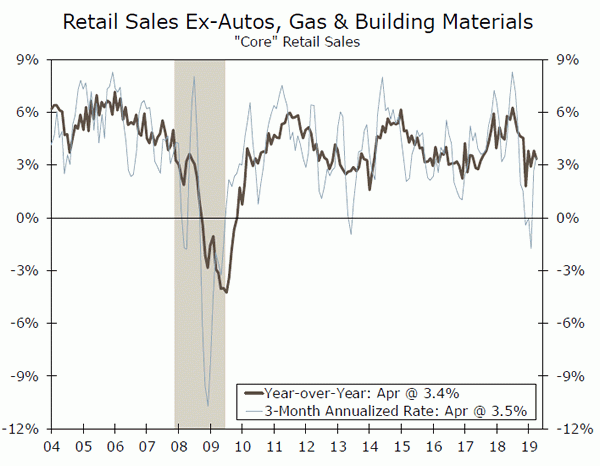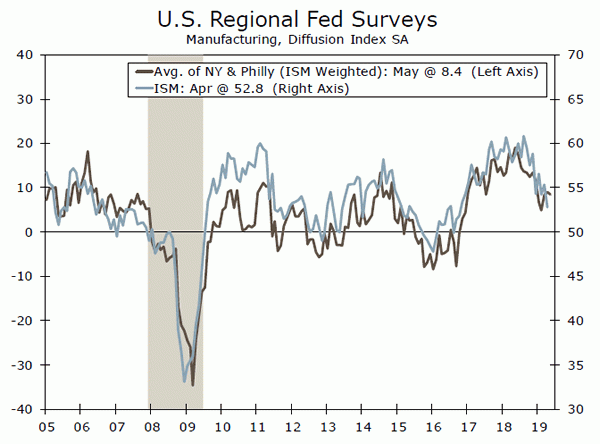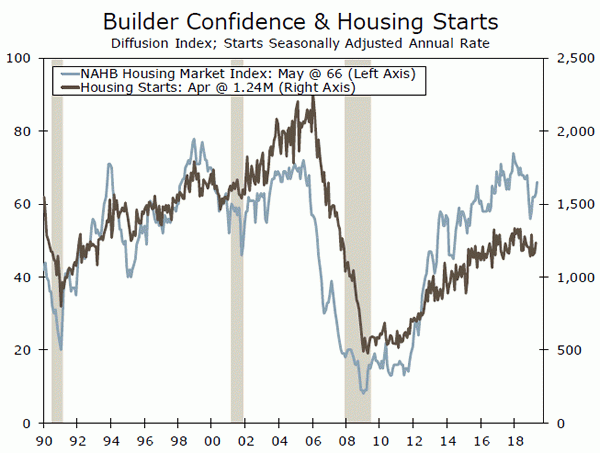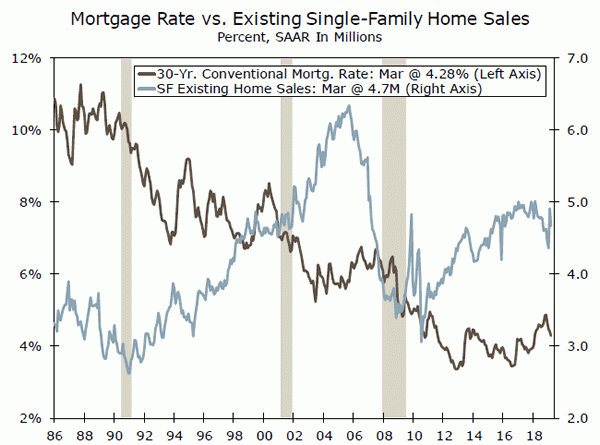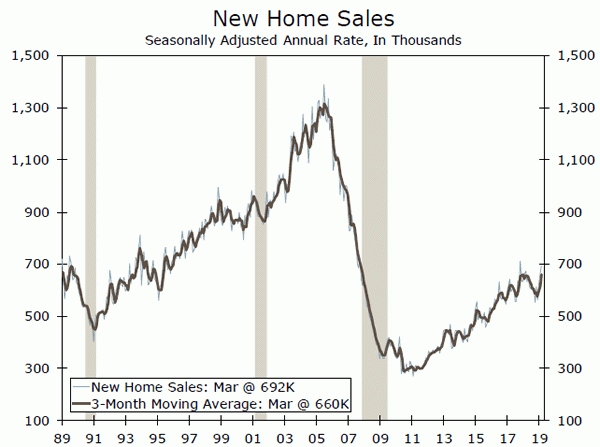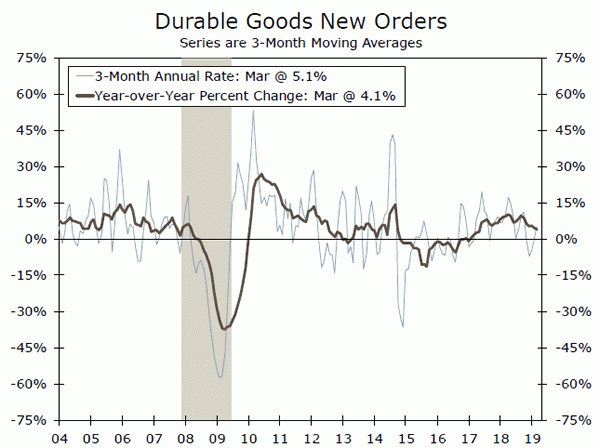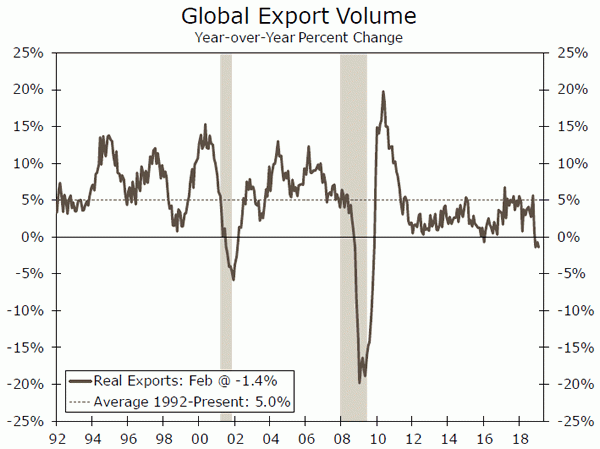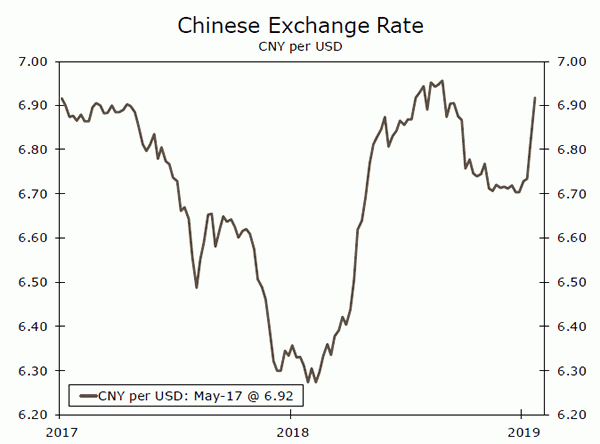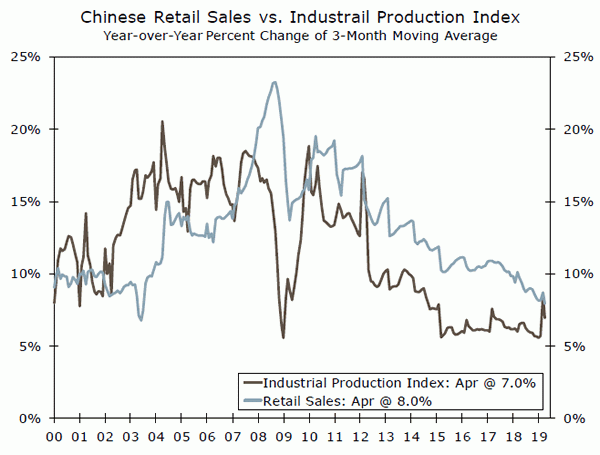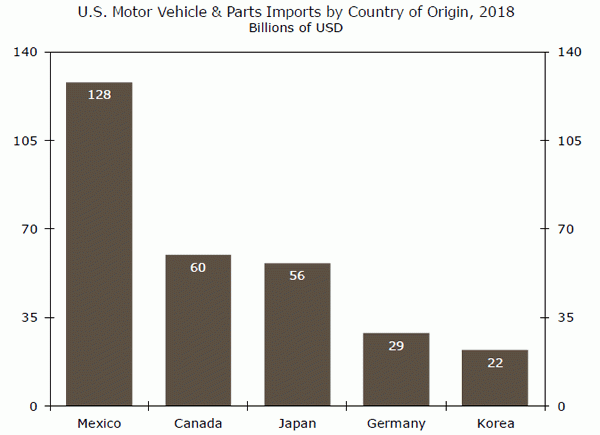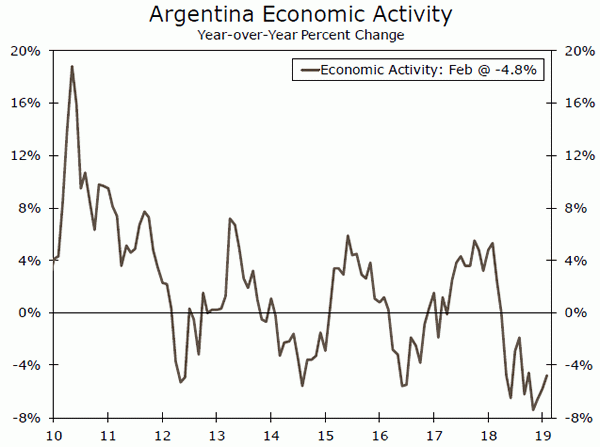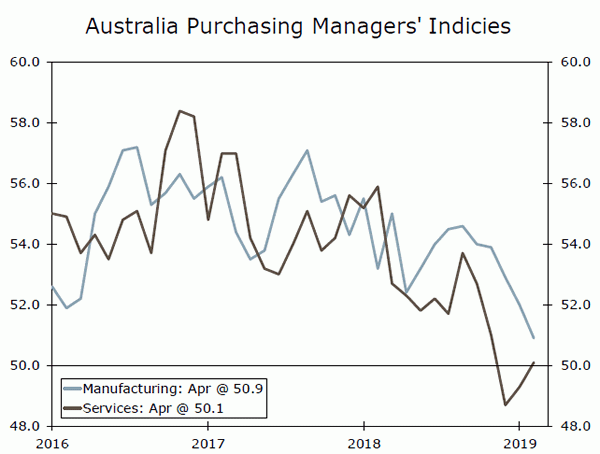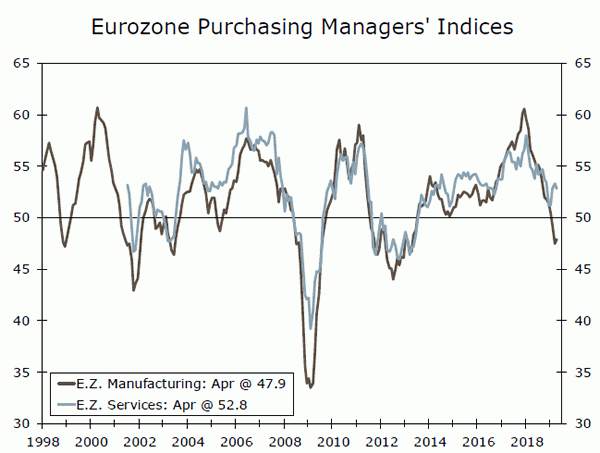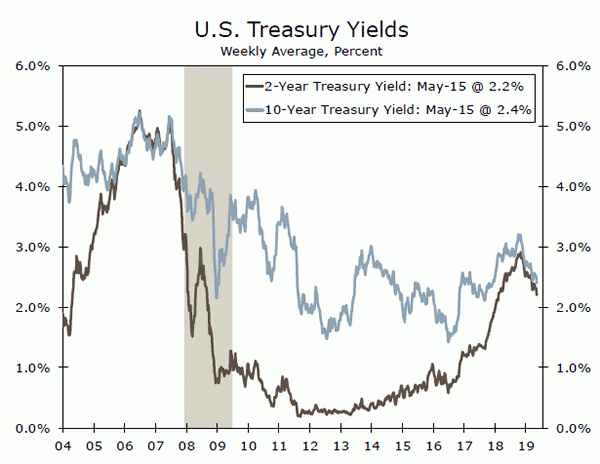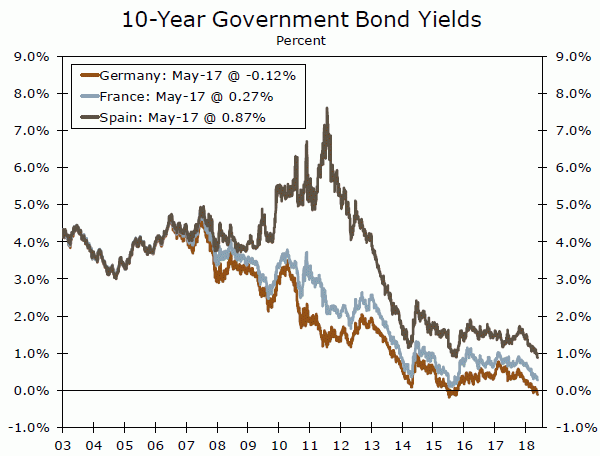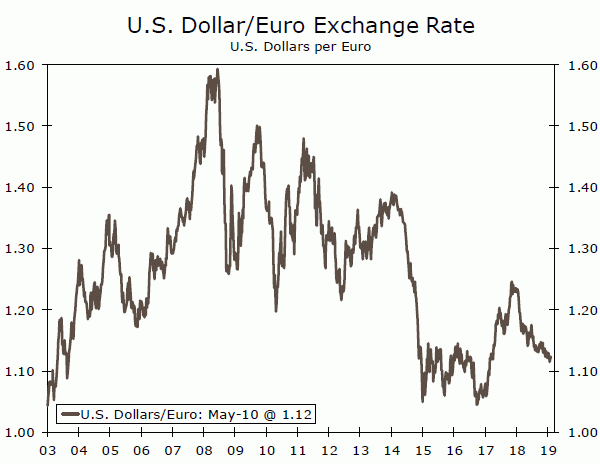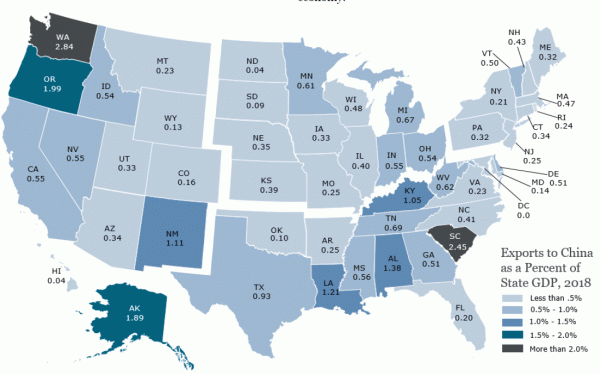U.S. Review
Two Steps Back and One Step Forward
- Retail sales stumbled again in April, falling 0.2%. Core retail sales were flat and suggest the Q2’s bounceback in consumer spending may not be as strong as previously thought.
- Output in the manufacturing sector fell 0.5% in April. The industry was already struggling before the recent trade war escalation due to slower global growth and the stronger dollar.
- Housing starts increased 5.7% in April and point to residential investment growing in Q2 for the first time in six quarters.
At Least Housing is Looking Better
Trade tensions were top of mind again this week, with markets keeping a close eye on negotiations between the U.S. and China as well as the Trump administration’s decision to impose broad tariffs on auto-related imports (the decision was delayed six months). Consumer spending and business investment were already looking somewhat shaky before the most recent tumult, however.
Retail sales stumbled again in April, falling 0.2%. As expected, weaker auto sales dragged down the headline, but core sales were also flat. We continue to expect consumer spending to strengthen in the second quarter after a paltry showing in Q1. Personal spending jumped 0.9% in March, which puts outlays in a good spot to start the quarter. Continued strength in the labor market, including a 16K drop in initial jobless claims this week, should further underpin a rebound. However, April’s underwhelming retail sales report suggests the pickup may be more modest than previously thought.
Near-term growth does not look to be getting much help from manufacturing and business investment either. Industrial production fell 0.5% in April. A drop in utilities output offset an increase in mining. The real sore spot in the report, however, was the 0.5% drop in manufacturing output. Consistent with softness at the retail level, auto production fell 2.6%, but just as weak was production of machinery—an ominous sign for business investment. Output in the manufacturing sector has not risen since December and is down 1.6% since then.
In early May, there were at least a few glimpses of factory activity beginning to turn around. Both the Empire and Philly Fed surveys improved more than expected in May. General sentiment was a bit better than the details when looking at each index on an ISM-weighted basis (the headline for each survey is derived from a separate question on general business conditions). One factor weighing both ISM-weighted Fed indices, however, was a contraction in inventories. Given the massive build in the first quarter, a reduction was inevitable and suggests orders remain strong enough to where production should firm up soon, barring a further escalation in the trade war.
With tariffs upped at the tail-end of the survey periods for the Empire and Philly Fed indices, May’s improvement in general sentiment may be short-lived. The same may prove true for small businesses. The NFIB Small Business Optimism Index rose to a four-month high in April, but smaller firms have less bargaining power with suppliers and are therefore more susceptible to higher input costs. Owners had already begun reporting poor sales as a growing concern, suggesting limited scope to pass on higher prices.
At least the recent pickup in the housing market remains on track. Housing starts rose 5.7% in April. Building permits also improved, and do not look to have been quite as low as previously thought. The pullback in mortgage rates, lower material costs and improved builder sentiment should help to keep the rebound in residential construction intact.
U.S. Outlook
Existing Home Sales • Tuesday
Sales of existing homes gave back some February’s 11.2% surge and fell 4.9% during March. Sales declined in each of the four census regions last month; however, the National Association of Realtors noted that the pullback was most acute in higher-priced markets adversely impacted by new limitations on state and local tax deductions brought on by the new tax law.
While resales have been running somewhat soft, they are by no means weak and have averaged a 5.21 million-unit pace in the first three months of the year. Demand has been comparatively stronger at more affordable price points, where inventory is still relatively scarce. Overall, we look for a sturdy gain in existing home sales during April. Mortgage rates remain low, which has led to purchase applications steadily trending higher. Furthermore, pending home sales, which represent signed contracts and lead closings by a month or two, rose 3.8% during March.
Previous: 5.21M Wells Fargo: 5.37M Consensus: 5.35M
New Home Sales • Thursday
The broad improvement in buying conditions should keep new home sales on an upward trend over the next several months. That said, a repeat of last month’s 4.5% surge in sales is unlikely. We look for a modest drop in sales to a still-solid 685,000 unit pace during April.
Similar to resales, new home sales have been strengthening at lower price points. During March, an estimated 50% of sales were priced below $300,000, which is up from around the 43% average during 2018. Homebuilders have mostly responded in kind and shifted their focus toward constructing lower-priced homes. Builders have also responded to rising inventories by offering price discounts to entice potential buyers off the sidelines. As a result, the median sales price fell 9.7% year-over-year to $302,700 in March, the fifth consecutive drop (by that measure). Easing home prices and lower mortgage rates should lay the groundwork for a modest pickup in new home sales over the next few months.
Previous: 692,000 Wells Fargo: 685,000 Consensus: 677,000
Durable Goods Orders • Friday
Durable goods orders rebounded in March, rising 2.6%. February’s initial 1.6% drag was also revised higher to a more moderate 1.3% decline. In recent months orders have been influenced by aircraft orders, which tend to be highly volatile. The commercial aircraft sector is likely to reprise its starring role in April’s report. The grounding of the Boeing 737 MAX and subsequent negative headlines have led to net cancellations, which will weigh heavily on April’s outcome as aircraft orders account for roughly 10% of the total. As a result, we expect total orders fell 3.8% during April.
Industrial production fell 0.5% during April, and the machinery production component dropped 2.6%, an indication that weakness in durable goods orders may extend beyond the aircraft sector. Excluding transportation, we look for March’s 0.4% gain to be followed by a 0.2% decline during April.
Previous: 2.6% Wells Fargo: -3.8% Consensus: -2.0% (Month-over-Month)
Global Review
Global Trade Relations Continue to Dominate Headlines
- Trade tensions between the U.S. and China continue to escalate, with China officially announcing reciprocal tariffs on $60B of U.S. exports. Chinese state media suggested trade negotiations are on hold for now; however, President Trump has indicated he will meet with President Xi at the G20 summit to discuss trade relations between the two countries.
- Despite deteriorating trade relations with China, President Trump has delayed imposing tariffs on autos and auto parts for 180 days. Optimism surrounding the USMCA trade agreement has increased as media reports suggest the U.S., Mexico and Canada are close to a deal to lift tariffs on steel and aluminum.
Global Trade Relations Remain in Focus
Following President Trump’s increase in tariffs on Chinese exports, relations between the major trading partners continue to stay in focus and impact global financial markets. U.S.-China trade tensions continue to dominate headlines, with China officially announcing retaliation measures, placing reciprocal tariffs on $60B of U.S. exports to China. In response to China’s tariffs, the U.S. administration has escalated trade tensions even further, with President Trump recently signing an order designed to restrict major Chinese corporations from accessing U.S. markets. Should the U.S. move forward with implementing these restrictions, this would risk damaging relations with China even further and make finding common ground towards making a comprehensive trade deal more challenging. President Trump also suggested Chinese authorities have a one month timeframe to agree on a trade deal or the remaining $300B in Chinese exports could be subject to tariffs as well. Given the hardline approach by the United States, Chinese state media suggested trade negotiations may be on hold for now; however, President Trump has indicated he will meet with Chinese President Xi at the upcoming G20 meeting in mid-June to discuss trade relations. We expect financial markets to remain volatile in the lead up to the G20 meeting, with any further escalation likely to put additional pressure on the Chinese renminbi.
While existing tariffs have not had a material impact on the Chinese economy, Chinese economic data released this week underperformed expectations. Chinese industrial production in April increased 5.4% year-over-year, missing consensus forecasts of 6.5%, while retail sales rose only 7.2% year-over-year, also softer than expectations for an increase of 8.6%. China’s weaker-thanexpected economic activity data have renewed concerns that global GDP growth may be decelerating more quickly than previously forecasted. Should the United States move forward with 25% tariffs on all of China’s exports, we would expect a more pronounced impact on global GDP growth, as well as China’s domestic growth trajectory.
Despite elevated trade tensions between the United States and China, President Trump provided some temporary optimism for global trade relations, as he decided to delay the imposition of tariffs on autos and auto parts coming into the United States. Similar to the China deadline, President Trump has given the EU and Japan 180 days to make a deal on how to limit the number of autos and auto parts being exported to the United States, once again citing national security issues. While Mexico and Canada are two of the larger exporters of autos and auto parts to the United States, both countries would be protected under the new USMCA trade agreement. Although yet to be ratified by each country’s respective congress, the U.S. administration provided renewed optimism for final ratification of the USMCA as well. Media reports suggest that the United States, Mexico and Canada are close to finalizing a deal which would remove existing tariffs on steel and aluminum. Should steel and aluminum tariffs be lifted, the prospects for the USMCA to be ratified would increase as tariffs have been a key point of contention to finalizing the USMCA trade agreement.
Global Outlook
Argentina Economic Activity • Wednesday
Argentina’s economy remains in recession following the country’s currency crisis and extreme monetary tightening in 2018. While we expected the economy to remain fragile, Argentina’s economy has not recovered the way we expected it to at this point. The economic activity index, widely used a proxy for tracking Argentina’s progress towards economic recovery, contracted 4.8% year-over-year in February and has been contracting on a year-over-year basis since May 2018. The health of the economy will likely play an important role in Argentina’s presidential election later this year. In a recent poll, potential voters cited the health of the domestic economy as their primary concern. With the economic activity index likely to contract again in March, and with CPI inflation hitting a new high of 55.8% year-over-year in April, the probability of market-friendly Mauricio Macri being re-elected is likely to continue to decline even further.
Previous: -4.8% (Year-over-Year)
Australia PMIs • Wednesday
Australia’s economy has been slowly deteriorating for some time now, as the country is particularly exposed to China’s decelerating economy as well as U.S.-China trade tensions. Leading economic indicators suggest the economy will continue to slow, although next week’s manufacturing and services PMIs may give markets an indication of just how pronounced the deceleration may be. As of now, both PMIs remain in expansion territory, but been trending lower since the end of 2018. Given the underwhelming performance of the economy, we believe the Reserve Bank of Australia (RBA) will look to ease monetary policy and cuts to its Cash Target Rate this year. Markets have taken a similar view as well, with implied policy rates pricing in two interest rate cuts from the RBA over the next 12 months. Policy rate cuts could help stabilize the economy, but any further escalation in U.S.-China tariffs would likely weigh on the economy.
Previous: 50.9 (Manufacturing), 50.1 (Services)
Eurozone PMIs • Thursday
Despite soft manufacturing and a relatively subdued services sector, the Eurozone economy grew at a 0.4% quarter-over-quarter pace in Q1. However, we believe it is too early to say the European economy has bottomed out and is on the path to recovery, which should keep investors and ECB policymakers particularly focused on PMIs for any further indications of how the economy is performing. As of now, the services sector remains in expansionary territory, and despite expectations for a modest improvement, the manufacturing PMI is likely to remain in contraction for the time being. Amid a backdrop of a fragile economy and subdued sentiment data, we continue to believe ECB policymakers will remain on hold through the end of this year, but may look to reduce accommodative monetary policy in 2020 if a sustained recovery starts to takes shape.
Previous: 47.9 (Manufacturing), 52.8 (Services) Consensus: 48.1 (Manufacturing), 53.0 (Services)
Point of View
Interest Rate Watch
Rates Continue to Move Lower
Yields on U.S. Treasury securities have generally been in retreat recently due to concerns over an escalating trade war. Not only has volatility in the stock market risen, which has led to safe-haven buying of Treasury securities, but market participants have inferred that the growth-depressing effects of a trade war would lead the Fed to cut rates. The yield on the 2-year Treasury security fell to a 15-month low this week, and the yield on the 10-year Treasury matched its low for 2019 (top chart).
But lower government bond yields have not been confined solely to the United States. The yield on the 10-year German government bond fell to its lowest level in nearly three years this week (middle chart). Indeed, yields on German government bonds are negative out through the 10-year maturity. Yields on many other European sovereign bonds fell to multi-year lows this week as well.
As we have written previously, we believe that the Fed would look through any nearterm increase in inflation that would result from higher tariffs on U.S. imports. And we agree with the market assessment that a trade war would bring forward expected Fed rate cuts. A month ago, market pricing indicated that investors thought there was a 40% probability that the Fed would cut rates by the end of the year. That probability is nearly 80% today. Although we think that the odds of a Fed rate cut by December are significantly lower than 70%, we acknowledge that a full-blown trade war, should one occur, would lead the Fed to cut rates.
Although the odds of Fed easing have risen recently, the U.S. dollar has generally strengthened recently. As shown in the bottom chart, the euro is approaching a two-year low vis-à-vis the greenback. Although the odds of a Fed rate cut have risen recently, the probability of further easing by foreign central banks has also gone up. For example, the probability that the ECB would cut its deposit rate, which currently stands at -0.40%, was less than 10% a month ago. That probability today it is up to about 25%. Restrictions on imported cars, should they materialize, would be especially onerous for the German economy.
Credit Market Insights
All Quiet on the Treasury Front?
News this week from state-run media that Chinese officials were discussing large scale selling of U.S. Treasurys gave rise to fresh fears that China will use its sizable holdings of U.S. government debt as another front of the trade war to retaliate over tariff escalations. Hard data released on Wednesday revealed that China sold a net $20.4 billion of Treasurys in March, which was before the latest round of tariffs hikes but nevertheless its largest unloading in over two years. China has now reduced its holdings for five of the past six months. Yet yields have fallen significantly over this period, as domestic investors continue to be drawn to the risk-return tradeoff of U.S. government debt. While China is the largest foreign owner, its $1.1 trillion of holdings is a fraction of the $22 trillion of Treasurys outstanding. Any dramatic unloading of Treasurys would also be partially selfdefeating. A spike in yields would decrease the value of China’s remaining portfolio of Treasurys, which represent perhaps the most viable option for its substantial foreign reserves, in terms of liquidity and yield. Moreover, selling would exert downward pressure on the dollar versus the yuan, hindering the competitiveness of Chinese exporters precisely at a time when they could use some relief. In short, rapid Chinese selling of Treasurys likely will not cause a significant spike in yields. Such a move would entail self-inflicted damage for China, while demand for U.S. government debt has been consistently robust and increasingly domestic.
Topic of the Week
All Trade Wars are Local
Beginning on June 1, China will raise tariffs on $60 billion dollars of U.S. goods to as high as 25%, in retaliation for a similar U.S. tariff hike on $200 billion of Chinese goods that took effect May 10. The S&P 500 fell almost 2.5% on Monday as the prospects of a prolonged and more pronounced trade war increased. Only around 7% of total U.S. exports head to China, and on a value-added basis, exports to China account for less than 1% of the U.S. economy. Yet this masks the underlying trade exposures of various states, some of which are much more susceptible to disruptions to trade with the world’s second largest economy. Looking at exports to China as a percent of state GDP, Washington, South Carolina and Oregon are the most exposed—not surprising given that all are home to large port complexes and a bevy of advanced manufacturing firms. Texas leads on a dollar basis, exporting $16.6 billion to China in 2018, followed by California and Washington at $16.3 billion and $16.0 billion, respectively. Only one other state, South Carolina, exported more than $5 billion to China last year. The methodology is worth noting here. Exports reflect the ‘origin of movement’, which is where goods are consolidated. Agricultural products from inland states that are ‘consolidated’ at a port are therefore counted in the exports for the port state. The effect is to understate the export exposure of agriculturally focused states and overstate exposure for states with ports. Indeed, farmers have been hit particularly hard by retaliatory Chinese tariffs and plunging commodity prices, pushing the Trump administration to pledge as much as $20 billion in relief funds, despite the low exposure on paper. Moreover, the economic impact of trade extends well beyond the value of the goods in transit. For example, while manufactured goods produced and consolidated in Ohio are counted in that state’s GDP, their transport and export from ports across the Eastern seaboard support an array of logistics and distribution jobs in various other states. Industry-level employment data in trade-dependent regions can thus serve as a harbinger for the rest of the nation, and provide clues to the extent of the trade war’s effect on the broader economy.




